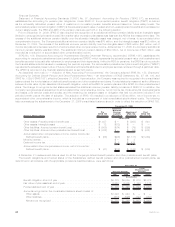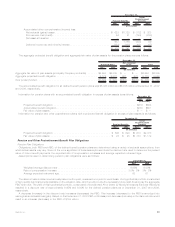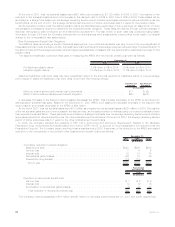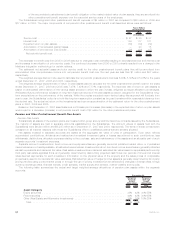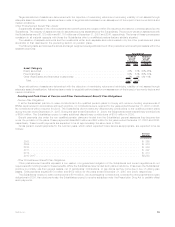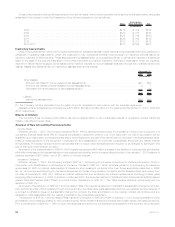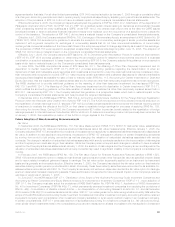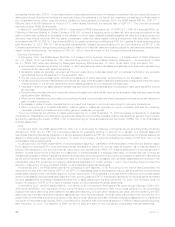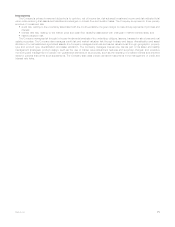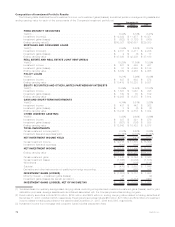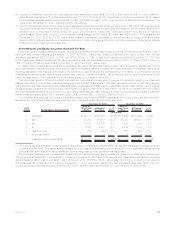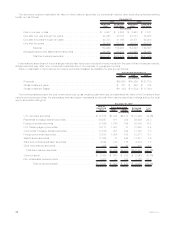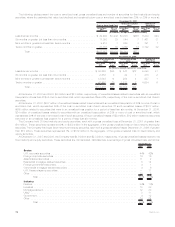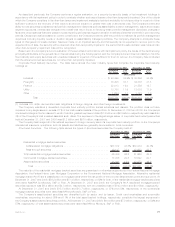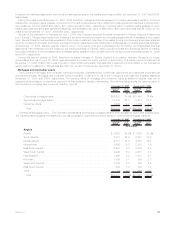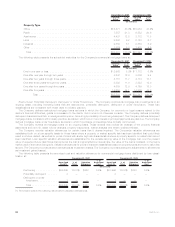MetLife 2007 Annual Report Download - page 74
Download and view the complete annual report
Please find page 74 of the 2007 MetLife annual report below. You can navigate through the pages in the report by either clicking on the pages listed below, or by using the keyword search tool below to find specific information within the annual report.companies. Additionally, SOP 07-1 precludes retention of specialized accounting for investment companies if the reporting entity does not
distinguish through documented policies the nature and type of investments to be held in the investment companies from those made in
the consolidated group where other accounting guidance is being applied. In February 2008, the FASB issued FSP No. SOP 7-1-1,
Effective Date of AICPA Statement of Position 07-1, which delays indefinitely the effective date of SOP 07-1. The Company is closely
monitoring further FASB developments.
In May 2007, the FASB issued FSP No. FIN 39-1, Amendment of FASB Interpretation No. 39 (“FSP 39-1”). FSP 39-1 amends FIN No. 39,
Offsetting of Amounts Related to Certain Contracts (“FIN 39”), to permit a reporting entity to offset fair value amounts recognized for the
right to reclaim cash collateral (a receivable) or the obligation to return cash collateral (a payable) against fair value amounts recognized for
derivative instruments executed with the same counterparty under the same master netting arrangement that have been offset in
accordance with FIN 39. FSP 39-1 also amends FIN 39 for certain terminology modifications. FSP 39-1 applies to fiscal years beginning
after November 15, 2007. FSP 39-1 will be applied retrospectively, unless it is impracticable to do so. Upon adoption of FSP 39-1, the
Company is permitted to change its accounting policy to offset or not offset fair value amounts recognized for derivative instruments under
master netting arrangements. The adoption of FSP 39-1 will not have an impact on the Company’s financial statements.
Business Combinations
In December 2007, the FASB issued SFAS No. 141 (revised 2007), Business Combinations — A Replacement of FASB Statement
No. 141 (“SFAS 141(r)”) and SFAS No. 160, Noncontrolling Interests in Consolidated Financial Statements — An Amendment of ARB
No. 51 (“SFAS 160”) which are effective for fiscal years beginning after December 15, 2008. Under SFAS 141(r) and SFAS 160:
• All business combinations (whether full, partial, or “step” acquisitions) result in all assets and liabilities of an acquired business being
recorded at fair value, with limited exceptions.
• Acquisition costs are generally expensed as incurred; restructuring costs associated with a business combination are generally
expensed as incurred subsequent to the acquisition date.
• The fair value of the purchase price, including the issuance of equity securities, is determined on the acquisition date.
• Certain acquired contingent liabilities are recorded at fair value at the acquisition date and subsequently measured at either the higher
of such amount or the amount determined under existing guidance for non-acquired contingencies.
• Changes in deferred tax asset valuation allowances and income tax uncertainties after the acquisition date generally affect income
tax expense.
• Noncontrolling interests (formerly known as “minority interests”) are valued at fair value at the acquisition date and are presented as
equity rather than liabilities.
• When control is attained on previously noncontrolling interests, the previously held equity interests are remeasured at fair value and a
gain or loss is recognized.
• Purchases or sales of equity interests that do not result in a change in control are accounted for as equity transactions.
• When control is lost in a partial disposition, realized gains or losses are recorded on equity ownership sold and the remaining
ownership interest is remeasured and holding gains or losses are recognized.
The pronouncements are effective for fiscal years beginning on or after December 15, 2008 and apply prospectively to business
combinations. Presentation and disclosure requirements related to noncontrolling interests must be retrospectively applied. The Company
is currently evaluating the impact of SFAS 141(r) on its accounting for future acquisitions and the impact of SFAS 160 on its consolidated
financial statements.
Other
In February 2008, the FASB issued FSP No. FAS 140-3, Accounting for Transfers of Financial Assets and Repurchase Financing
Transactions (“FSP 140-3”). FSP 140-3 provides guidance for evaluating whether to account for a transfer of a financial asset and
repurchase financing as a single transaction or as two separate transactions. FSP 140-3 is effective prospectively for financial statements
issued for fiscal years beginning after November 15, 2008. The Company is currently evaluating the impact of FSP FAS 140-3 on its
consolidated financial statements.
In January 2008, the FASB cleared SFAS 133 Implementation Issue E23, Clarification of the Application of the Shortcut Method (“Issue
E23”). Issue E23 amends SFAS 133 by permitting interest rate swaps to have a non-zero fair value at inception, as long as the difference
between the transaction price (zero) and the fair value (exit price), as defined by SFAS 157, is solely attributable to a bid-ask spread. In
addition, entities would not be precluded from assuming no ineffectiveness in a hedging relationship of interest rate risk involving an
interest bearing asset or liability in situations where the hedged item is not recognized for accounting purposes until settlement date as long
as the period between trade date and settlement date of the hedged item is consistent with generally established conventions in the
marketplace. Issue E23 is effective for hedging relationships designated on or after January 1, 2008. The Company does not expect the
adoption of Issue E23 to have a material impact on its consolidated financial statements.
In December 2007, the FASB ratified as final the consensus on EITF Issue No. 07-6, Accounting for the Sale of Real Estate When the
Agreement Includes a Buy-Sell Clause (“EITF 07-6”). EITF 07-6 addresses whether the existence of a buy-sell arrangement would preclude
partial sales treatment when real estate is sold to a jointly owned entity. The consensus concludes that the existence of a buy-sell clause
does not necessarily preclude partial sale treatment under current guidance. EITF 07-6 applies prospectively to new arrangements entered
into and assessments on existing transactions performed in fiscal years beginning after December 15, 2008. The Company does not
expect the adoption of EITF 07-6 to have a material impact on its consolidated financial statements.
In November 2007, the SEC issued SAB No. 109, Written Loan Commitments Recorded at Fair Value through Earnings (“SAB 109”),
which amends SAB No. 105, Application of Accounting Principles to Loan Commitments. SAB 109 provides guidance on: (i) incorporating
expected net future cash flows when related to the associated servicing of a loan when measuring fair value; and (ii) broadening the SEC
staff’s view that internally-developed intangible assets should not be recorded as part of the fair value of a derivative loan commitment or to
written loan commitments that are accounted for at fair value through earnings. Internally-developed intangible assets are not considered a
component of the related instruments. SAB 109 is effective for derivative loan commitments issued or modified in fiscal quarters beginning
after December 15, 2007. The adoption of SAB 109 will not have an impact on the Company’s consolidated financial statements.
70 MetLife, Inc.


